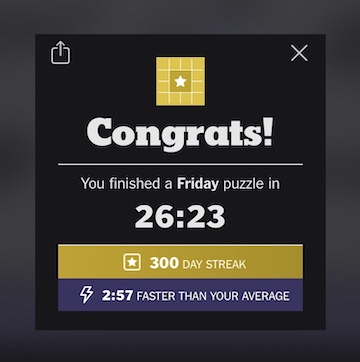We’ve all heard the adage from Chinese philosopher Lao Tzu, “The journey of a thousand miles begins with a single step.” And the journey of a 300-day streak in the New York Times crossword begins with… crossword #1! In all honesty, I didn’t set out to accomplish such a long streak, in which each puzzle is finished within its allotted 24-hour time period. I’ve never had more than a streak of a couple weeks in a row before. But over the past year, I’ve had the ability to devote a chunk of time to the crossword every day. Once I hit 100, I began to take the streak seriously. And here we are, at Day 300! Over the course of this 300-day streak, I’ve learned a lot—not just about crossword trivia or wordplay tricks, but also about myself.
Big numbers (like 300) make me contemplative. I’ve been messing around with the New York Times crossword since mid-2017, but I never really had a streak because I could only complete the Monday and Tuesday crosswords. The way the NYT crosswords are set up, Mondays are the easiest days of the week, and the crosswords get progressively harder as the week goes on (with the semi-exception of Sunday, which I’ll get to in a moment). Monday through Thursday crosswords almost always have some kind of theme to them, which can sometimes give the solver a bit of an edge in terms of deducing the patterns or tricks of the puzzle. (Or sometimes the themes can drive solvers crazy, especially if it’s a love-it-or-hate-it rebus! For the record: I love a good rebus.) Friday and Saturday are themeless puzzles and are considered the hardest days of the week, with lots of tricky clues, esoteric vocabulary, and misdirects. The Sunday puzzle is pegged at a midweek level of difficulty and usually has a clever theme; its main challenge is that the grid is twice as big as the weekday puzzles and so takes longer to solve.
So when I started doing the crossword in the fall of 2017, I could only consistently do the Monday and Tuesday puzzles, and they were no walk in the park for me—Mondays would take me about 15 minutes to get through, and Tuesdays were in the 20–30 minute range. After about four months of this, I got brave enough in early 2018 to try the rest of the week’s puzzles. I was occasionally able to do all of the puzzles for one week, but usually I would complete Monday, Tuesday, and Wednesday, and then leave Thursday, Friday, Saturday, and some Sundays incomplete. This pattern lasted for more than a year, until in early 2019 I began to complete more Thursdays and even the occasional Friday, although I still left Saturdays mostly untouched. April 2019 was my first month in which I (eventually) finished every crossword, although they didn’t count as streaks because I didn’t finish all of them within the 24-hour mark. But once I accomplished this feat, I knew that I could handle any day of the week, as long as I had enough time to devote to it.
What I learned from 300 days of doing the crossword—and, in reality, several years of doing the crossword—is that each of us has the ability to learn and grow and get better at something over time. If we just keep practicing and learning (from our own experiences and from those around us), we can learn to do new things and we can learn to do them better and better over time. Often, people get stuck in fixed mindsets—assuming that our talents and skills are fixed at a certain level, and we either have what it takes to succeed, or we don’t. Doing the crossword for 300 days in a row—and watching myself get better at the crossword over a period of several years—has helped me reignite my growth mindset: the belief that I can get better at new things if I try. It’s a nice mindset to have!
